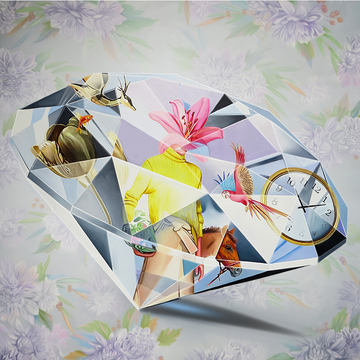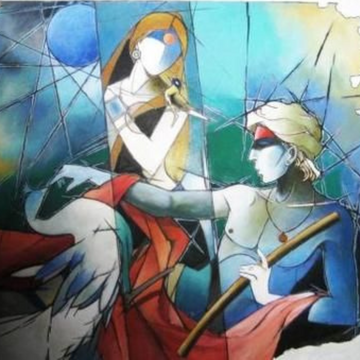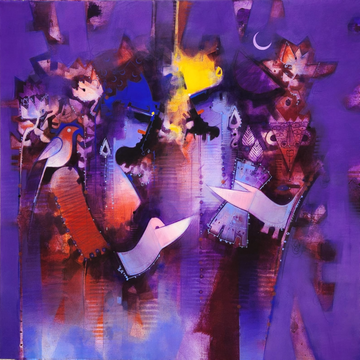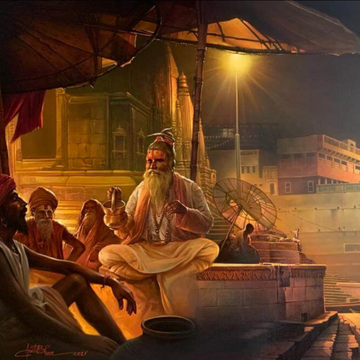A Surrealistic Delight – Suraj Kumar Kashi’s Inimitable Depictions of Modern Life

When one encounters a Suraj Kumar Kashi painting, one immediately realizes that a look is not enough. An interaction, a hunger for a conversation of sorts immediately ensues with the canvas, engaging the observer.
At first, the visual appeal strikes you in a luxurious, sumptuous manner, soothing your eyes upon the fuchsias and pinks of the roses and the lilies, the soft clouds against a clear blue sky and the elegance of birds and female forms.
Then, magically, the spectacle also gives birth to an intrigue in the mind of the spectator, urging him to approach the canvas, zoom into each detail and burden the painting with elaborate scrutiny.

The painting responds, each and every element a surreal world in itself, reciprocating with its own exquisite identity, but at the same time in total harmony with its surrounding worlds on canvas. An explosion of ethereal microcosms – luxurious chairs, carved photo frames, antique cars, chandeliers, sparkling jewels, ornate musical instruments – within an opulent macrocosm.
The Roots of Novelty
The underlying thread that weaves the multiplicity of elements in each of Suraj Kumar’s unparalleled masterpieces is a comparison of the simple, slow paced rural life with the hurried, excessive lifestyle of a modern metropolitan. Born in 1976, in a village of Jumui district in Bihar, Suraj Kumar Kashi was appreciated for his drawing skills since childhood. With the encouragement from peers and teachers, he went on to pursue a Bachelor’s degree in fine arts from the Art College, Patna and a Master’s degree from College of Art, Delhi University in 2003. He performed extremely well in his studies, being a gold medalist and then dove into a career in the advertising world as an art director at Ogilvy & Mather. However, during this journey, the migration from rural to urban life left an indelible impression on his mind and started trickling into the subjects on his canvas.
Aspects of the materialistic urban lifestyle of the upper middle class and the upper class, such as obsessive shopping in malls, a blind pursuit of brands, a superfluous indulgence in extreme luxuries to maintain one’s status in the society, lavish partying, an excessive emphasis on physical adornments and appearances, the bondage of corporate labor, a life spent under the fear of the clock, etc., intrigued him. In his mind, these spectacles were layered upon the reminisces of his early life in the village delineated by sights of cattle, lush green fields, domestic animals, village women on swings, etc. This concoction of contrasting observations swirling in his mind enabled him to develop a unique painting style of his own.

Unraveling the Symbolism
Each figure on Suraj Kumar’s canvas adds an important twist to the extravagant story. Birds, glossy feathers and elegant female forms tell tales of freedom and abundance of opportunities for women in urban areas. They represent an ability to soar in the clear skies and achieve their dreams. Shiny antique cars symbolize the status symbols of the rich, illustrating how an object, with its sole aim of transporting people from one place to another, can be used to parade wealth by just being parked at a place as a showpiece. Auto-rickshaws, modestly dressed people on motorcycles and farm animals are reminders of the humble ways of the rural life.
Horses are typically portrayed as an eternal continuum of time. If a body of a horse is disjointed, it is typically to show various stages of evolution of human life over time or the effect time has on a certain groups of the society. In one of his most popular works, Suraj had shown an array of urban people tumbling from the belly of a half-horse. These residents of big cities were displayed as being bound by time, perennially trapped in the vortex of haste and commotion. The same canvas also bore the freedom of a bird that was outside its cage, having conquered its metallic trap that hung from its beak. On another corner was the bliss of a village couple, their love blossoming like a flower even while riding a simple bicycle.

Intricately carved chairs with the most magnificent upholstery may be overturned on the canvas, representing their ownership by a wealthy man who doesn’t have enough time to sit on them and enjoy his possession. A male form in a business suit associated with imagery of ‘Hanuman’ is akin to the original Indian superhero from Hindu Mythology, Lord Hanuman, for his family as he goes out into the world to earn a living for his loved ones, enduring all obstacles and atrocities of life.
The list of such analogies captured by his brush is endless and quenches one’s creative thirst in the most fulfilling way.
Projects on Bricks
A keen observer of city life, Suraj Kumar saw young children selling books on the floors of popular markets like Connaught Place in Delhi, at an age when they themselves should have been reading those books. He also observed that in rural areas, child labor was rampant in brick kilns. Connecting the dots like no other, he decided to turn bricks into books through the magic of his art. Using acrylics, he painted the bricks as books and then sold these masterpieces to raise money to buy actual books for the same children who had inspired him to create this project. Hence, he proved that art is not just limited to the canvas, but can be extended to on-ground implementation and execution of a cause for the greater welfare of mankind.

The surfacing of many accounts of irony, emphasis on social causes, depictions of involvement in redundant quests, and the addictive dependency on material comforts inherent in our daily life in the most simple yet strikingly beautiful way through acrylics on canvas, Suraj Kumar exhorts us to rethink our place in the world and reevaluate the priorities of our pursuits.













